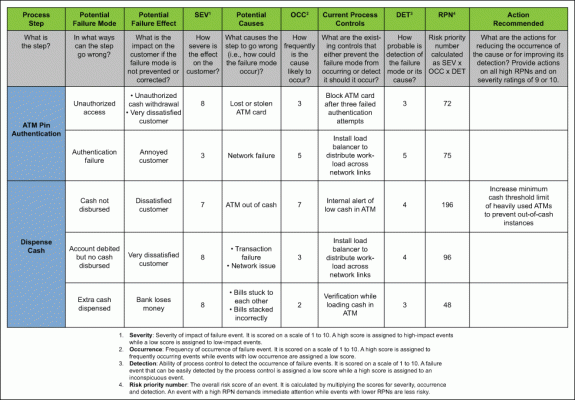
FMEA is a risk assessment tool. Through the structured approach of an FMEA, improvement teams identify possible ways in which a product or process can fail, specify the subsequent effects, quantify the severity of those potential failures, and assess the likelihood of their occurrence. FMEA can be used to rank and prioritize the possible causes of failures as well as develop and implement preventative actions, with responsible persons assigned to carry out these actions.

A systematic and semi-quantitative tool, an FMEA is usually created with a template (or a spreadsheet). The template, an example of which is shown below, guides the general steps for conducting an FMEA:
- Identify the steps of a process, or parts of a product.
- Identify possible failures modes. (In what way can the product or process fail? What can go wrong?)
- Identify the failure effects. (What is the impact on key process measures or product specifications?)
- Assess the severity of the potential failure. (How severe is the problem to the customer? 1 = least severe, 10 = most severe)
- Identify the potential causes of the failure.
- Assess the occurrence. (How frequently is this failure likely to occur? 1 = low occurrence, 10 = high occurrence)
- Identify the current detection modes. (What are the existing controls that either prevent the failure from occurring or detect it should it occur?
- Assess the detection of the failure. (How easy is this failure to detect?)
- Calculate the risk priority number, or RPN. (RPN = severity * occurrence * detection)
- For the potential failures with the highest RPN, create mitigation plans.
- Once the actions have been taken, recalculate the RPN to confirm the failure risk has been reduced.

Besides the obvious benefits of reducing product or process failures, an FMEA also has the benefit of capturing the collective knowledge of a team, documenting and tracking risk-reduction activities, and providing historical records for baseline performance.
To learn more about FMEA and related topics, refer to the following articles, discussions and Cox-Box cartoons on iSixSigma.com:
- Anderson’s FMEA
- FMEA Can Add Value in Various Project Stages
- FMEA: Tool for Process Documentation and Discovery
- Let’s Do an FMEA
- FMEA: Preventing a Failure Before Any Harm Is Done
- Quick Guide to Failure Mode and Effects Analysis
- What Is the Right Level of Detail?
Additional resources are available for purchase on the iSixSigma Marketplace:
- FMEA Scorecard
- Excel FMEA & Mitigation Planning Tool
- Failure Modes and Effect Reference Guide
- Failure Mode and Effects Analysis Training Slides
- FMEA Template: Effects Before Causes?
To read more FMEA articles, click here.